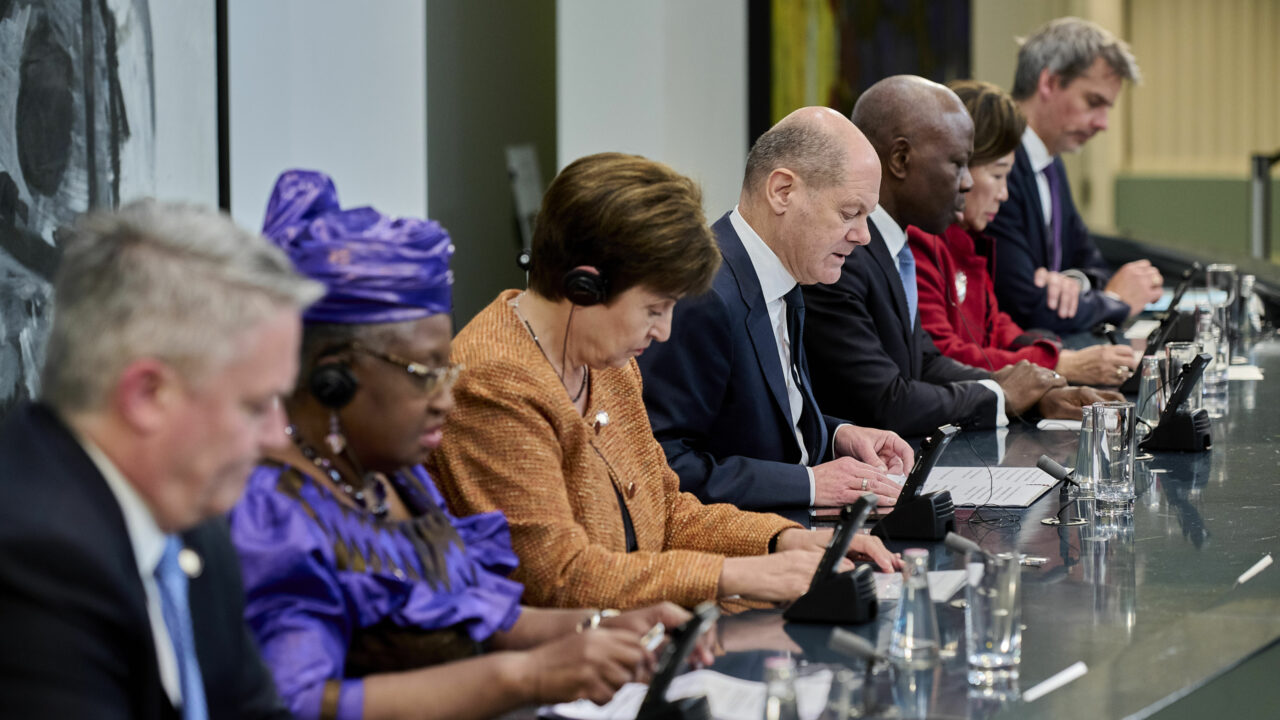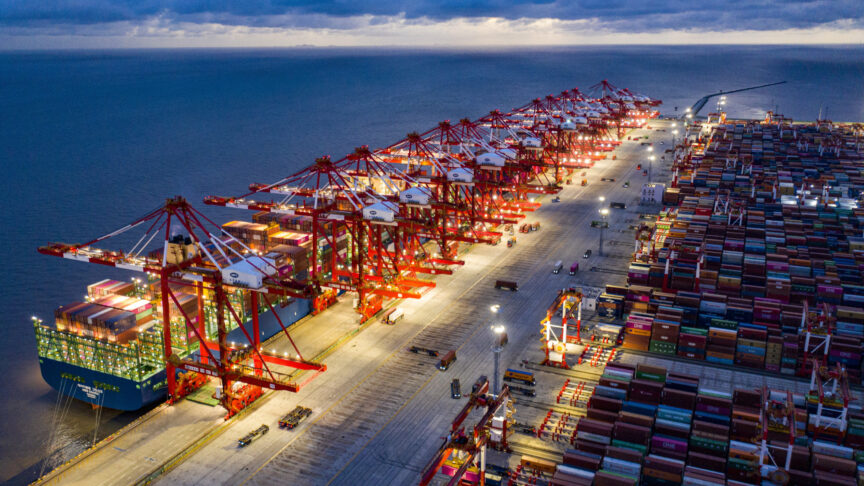Multilateral trade: The green European genie at the WTO
The EU’s use of trade policy in pursuit of its climate goals risks undermining its multilateral credentials and efforts to reform the WTO. To avoid this, it needs to take credible steps to reconcile its trade and climate agendas
The European Union is heavily reliant – for its growth, prosperity, and economic stability – on a functioning multilateral trading system. Since 1995, the World Trade Organization (WTO) has embodied that system. But the EU, the United States, and many non-Western actors now recognise the organisation as being in crisis. Europeans are among the prominent defenders of the existing system and key supporters of WTO reform. Yet, at the same time, the EU is increasingly using trade policy in service of its climate change agenda in ways that risk undermining the bloc’s multilateral credentials. For the EU to achieve both its trade and climate change goals, it needs to reconcile these two agendas.
A system in crisis
The European Commission understands the WTO crisis as comprising four main elements. Firstly, the organisation’s rules have not kept up with the changing patterns of global trade, which has diminished its negotiating function. Secondly, the WTO fails to ensure that all members comply with their obligation to report their trade measures. Thirdly, the organisation’s dispute settlement system has been paralysed since 2019, when the US began to block the appointment of appellate judges. These judicial vetoes stem from Washington’s own perception of the crisis – that is, its assessment that the WTO tends to hand down rulings that are either reflective of judicial overreach or just outright wrong.
Finally, the WTO’s rules and principles are straining under the weight of the geopolitical rivalry between the US and China (which are each other’s largest trade partners). The US has, for example, introduced major subsidies for a green economy and semiconductors that include stipulations for a minimum level of domestic production – or ‘local content requirements’ – whose use the WTO restricts. It has also unilaterally applied export controls to limit China’s access to advanced semiconductor technologies. US policymakers, in turn, maintain that the WTO has allowed Beijing to “hack” the rules to its own benefit. The Biden administration does not differ markedly from its predecessors in these assessments and its response, despite its declarative support for multilateralism.
Middle-income countries have their own set of concerns. In India and South Africa especially, leaders object to the WTO’s inability to incorporate their development interests into its agenda. They also tend to oppose a move from multilateral to plurilateral formats, which the EU and others have privileged in the face of the organisation’s broader negotiating deadlock.
Between reform and irrelevance
Yet, for all its problems, the WTO continues to play a crucial role as the pole of stability in global trade. The limbo in the organisation’s dispute-settlement system is unfortunate, but WTO members have committed to restore it by 2024. In the meantime, 47 members (including the EU) have created a functioning interim mechanism, which has already proven its usefulness in hearing a dozen disputes. At least two-thirds of world trade continues to be WTO-based, and informal talks on WTO reform started in 2022.
The US currently seems to be privileging its great power competition with China over the stability of the international trading system
The US, however, may not be ready to engage in a serious effort return the WTO to a reasonable state of functionality. It would need to unblock the appellate body and refrain from openly breaking the WTO’s rules, such as through further export controls. Indeed, the US currently seems to be privileging its great power competition with China over the stability of the international trading system. This risks the marginalisation of the WTO and increasing fragmentation of global trade.
Beijing, for its part, has no interest in further decay at the WTO – but nor is it likely to press for reform. China is the world’s major exporter and benefits hugely from the stability that the current WTO system provides. China also appears to have complied with the letter of its WTO commitments (even if some analysts argue that it has broken the “spirit” of the rules). It therefore has few reasons to accept any additional concessions that may come with reform. To the contrary, China benefits from American disengagement from the WTO by progressively strengthening its position in the organisation’s secretariat in Geneva. Moreover, the United States’ trade war on China provides Beijing with a cover for maintaining its various trade restrictions and industrial subsidies.
Europe’s twin goals
The EU and its member states are thus key defenders and reformers of the WTO system. But the bloc’s trade policy seems to be pulling it in opposite directions.
On the one hand, the EU is positioning itself as a leader in efforts to preserve and reform the WTO by addressing the elements of the crisis as the European Commission understands them. The EU relies for this on its like-minded partners from the Ottawa Group, who share a belief in the urgency of modernising WTO rules. But the EU also aims to reach a “high degree of convergence in the reform agenda” with the US, and is planning a major round of diplomacy with African countries to build consensus on WTO reform.
On the other hand, the EU is increasingly using trade policy in support of its efforts to combat climate change. This approach could be effective in addressing the bloc’s climate priorities. But it could also undermine the existing multilateral trading system. The most prominent of the EU’s initiatives in the trade-and-climate area is its Carbon Border Adjustment Mechanism (CBAM), which will apply higher tariffs on carbon-intensive goods entering the bloc. This initiative is proving highly controversial, as are recent directives on deforestation and corporate sustainability due diligence, mainly due to their unilateral character. India, for instance, has recently protested that the CBAM could amount to behind-the-border protectionism and has raised those concerns at the WTO Committee on Trade and Investment. Governments in southern Africa fear the CBAM’s economic consequences – since their exports to the EU are frequently based on carbon-intensive production.
Squaring the circle
The EU needs to engage in three types of actions to reconcile its trade and climate agendas.
Firstly, it should build stronger and more diverse coalitions. It has already begun to do this through its co-leadership of the Coalition of Trade Ministers on Climate, which Ecuador, the EU, Kenya, and New Zealand announced at the World Economic Forum in Davos earlier this year. The coalition involves more than 50 countries (including all EU member states) and aims to boost international cooperation on climate, trade, and sustainable development through discussions at a high, ministerial level. Notably, its membership goes beyond the usual suspects of the Ottawa Group and includes eight African members as well as the US. But it needs to prove its usefulness: the coalition still does not have an agreed agenda, and China and India are not on board. The EU and member states need to help build a broader coalition, with a critical mass, if the initiative is to exert pressure on the latter two – who are among the world’s largest CO2 emitters.
Secondly, the EU needs to defend its trade-and-climate measures. It should show readiness to engage in a two-way exchange with other WTO members on the design of its instruments and their implementation – and it holds strong cards to make its case. Even if the CBAM is a unilateral measure, the EU can still justify it under the rules of the WTO – whose jurisprudence has already overcome the alleged conflict between trade commitments and climate action. Moreover, trade experts underline that the true challenge is not in justifying the permissibility of CBAMs in principle, but in “ensuring that their design does not undermine their stated objectives”.
Finally, the EU should respond with care to the US Inflation Reduction Act. The bloc’s recent actions and statements suggest that it has opted for a non-confrontational approach to the United States’ set of green subsidies. The EU’s response involves loosening state aid rules to extend its own subsidies and trying to include European firms as far as possible in American supply chains and tax credit regimes. The French president, Emmanuel Macron, advocates that the bloc should adopt “Made in Europe” as its new motto.
This approach poses a risk for the EU’s reputation as a defender of a rules-based international trading system. However, leaders in Brussels seem to have concluded that they cannot afford (economically and strategically) to confront the US and China if these countries are pursuing a different line. Still, the EU should at least try to show that it can make industrial policy without resorting to local content requirements like the US. It should also aim to boost European competitiveness more broadly in ways that do not clash with WTO rules and principles. Ultimately, the EU needs to promote a multilateral or plurilateral agreement on permissible environmental subsidies – and this should engage all of the world’s largest CO2 emitters.
The EU would do the world a favour if it succeeded in driving global discussions on how to reconcile trade and climate regimes. This could even help the WTO to redefine its purpose. But, if leaders in Brussels are not vigilant and credible in their actions, they could further damage the international trust that is critical for the smooth functioning of the multilateral trading system on which they themselves rely.
Shapes of multilateralisms collection
Anthony Dworkin, Rafael Loss, Jana Puglierin (eds.)
This collection of nine insightful essays illuminates the strategies employed to advance European interests and values within the evolving global polity of overlapping cooperative frameworks.
The European Council on Foreign Relations does not take collective positions. ECFR publications only represent the views of their individual authors.



